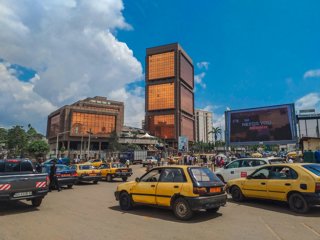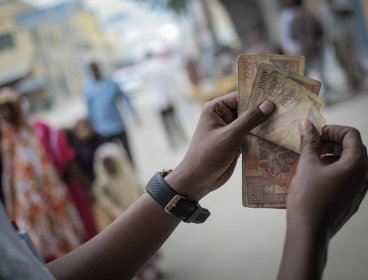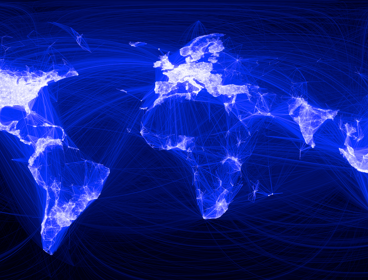Dr Ben Page is a Reader in Human Geography and African Studies at University College London. He specialises in development geography with a particular focus on the causes and impacts of migration in Cameroon, where he spent some time working as an engineer for an international NGO. We spoke to him about the modern African diaspora and the way remittances are transforming the continent.
What drew you to study and research diaspora and remittances networks in Africa in particular?
I have been working in Cameroon in central Africa for 20 years and right from the start of that time I have been aware of the importance of diasporas and remittances. When I first started volunteering on a community water project in a rural area I saw how important it was when people who had left the village came back from time to time to offer support, encouragement and money to those still living in the village. The money they sent was crucial for paying school fees and hospital bills for family members back home. The energy of those who had left the village was crucial to getting development projects at home up and running. Later when I was living in cities in Cameroon I used to socialise with those same people who had left that village and started to see things from their point of view too – in particular I started to learn about the heavy weight of expectation placed on them as individuals when family members demanded money. It was a complicated relationship between the benefits felt by those at home and the costs for those who had migrated that led to my research on the topic. Of course the migrants who send money gain a lot of respect and status too!
How has the nature of diaspora and remittances changed over time?
Remittances into Africa just keep on growing: they amounted to around US$25 billion in 2013; a significant amount when one compares that to a total of US$151 billion in development assistance from all the OECD countries that year. Technology has made a big difference. There are more mobile phone accounts in Africa than in North America, and this has enabled remittances to reach rural areas electronically; when I started going to Cameroon people still had to physically carry money to the village. African innovations like M-Pesa in Kenya and Tanzania have made ‘mobile money transfers’ quick, easy and quite cheap. Internationally however, things have not changed for the better – rather the reverse. Two international companies have effective monopolies over large parts of the money transfer market and Africans who want to send money home pay significantly more than any other diaspora as a result.
African diasporas have changed too. Second and third generation migrants are increasingly influential and have a very different attitude to their parents. They tend to be more confident, more technologically savvy and more entrepreneurial. Increasingly it is this generation that will shape the relationship with Africa.
Of course, remittances are not just about the transfer of money are they?
You are right. Remittances can be household goods, jewellery or machinery. Right now I am really interested in learning more about second-hand cars. Most cars in Africa are second hand and many individuals in the diaspora will send cars home via ships for their own use or for family members. Some of the diaspora have turned this into a business opportunity by becoming experts in car exporting. Some remittances are not even material things, they are ideas. These are called ‘social remittances’ and could involve things such as how to run a business effectively for example. Some people argue that the diaspora are transferring better developed world ideas about politics home to Africa too, but I think we have to be really careful about making claims like that because it assumes that ‘our’ politics are superior and these claims are very hard to prove too.
We mostly think of remittances as being rather personal, but your research also looks at Hometown Associations (HTAs) – what are these?
Hometown Associations are ‘clubs’ whose members share an interest in the town or region they all come from. So for example we worked in a town called Bali-Nyonga in rural Cameroon. It is a small town of fewer than 100,000 people, yet the people from the town who have left to live in other parts of the world still meet up together in order to look after each other, have fun and help those who are still back home. Their hometown association is called the Bali-Nyonga Development and Cultural Association and it has branches all over Cameroon as well as in the UK, Germany and different states of the USA. The international branches have their own names and constitutions but their aim is the same: to provide a social space where people from Bali-Nyonga can come together. These associations are of particular interest to development policy-makers because they provide organisations that can be enrolled into international development projects, but the problem is they are not found all over the world. In some places like Mexico and West Africa they are common and strong but they are not nearly so widespread in Eastern or Southern Africa.
One might assume therefore that working with HTAs is more sustainable and effective than current aid international programmes. Is this a fair assumption?
Yes and no. From a development perspective there are some real strengths to HTAs such as the fact that they have a long-term commitment to the places that interest them and they provide a very cheap means of delivering development when compared to professionals in the aid industry. They are also good at holding their leaders to account if something goes wrong because those leaders are members of the community. As well as this they can have a good understanding of local needs too. The problems stem from the fact that they do not always have much experience, so for example they do not always know how to monitor or evaluate their projects and they may not co-ordinate their activities across different sectors (like health and education) because their interventions are intermittent and small-scale. Sometimes they are over-ambitious about what they can do and sometimes they let the concerns and ideas of the diaspora members take priority over those at home. The UK Department for International Development, working with the NGO Comic Relief have a project called the Common Ground Initiative, which supports small diaspora organisations in the UK including HTAs.

Many rural migrants in Cameroon seek work in cities such as Yaoundé in order to send remittances home
An emotional connection to one’s community and a selfless spread of wealth are central ideas behind remittances. What lessons might the Global North learn from these practices of the Global South?
I agree with the idea that grouped remittances sent through an HTA illustrate a connection to your community, but I would be more cautious about making a claim that these donations are about a ‘selfless spread of wealth’ – altruism is part of the story but only part. People use these donations to assert their metaphorical presence ‘at home in Africa’ whilst they are literally outside the continent. That might well be about trying to retain a foothold for example in a claim over inheriting land or property for example. By sending money people are saying “I haven’t forgotten you… so don’t forget me either.”
In terms of lessons we could learn that we can be more relaxed about the relationship between emotional attachments to place and international migration. Lots of the members of HTAs are deeply emotionally attached to London and the UK and simultaneously to their hometowns in Africa. This is really not a peculiar thing or a problematic one.
What threats are there to HTAs becoming more deeply ingrained into international development policy?
When small organisations like HTAs start taking grants from larger institutions like the UK Government’s ministry of foreign aid; the Department for International Development (DfID) they have to accept certain rules. For example they have to abide by accountancy procedures when spending taxpayers money and they might have to register as formal organisations or have legal statuses, like charities. This means they might feel restricted in what they can do and they may have less autonomy and flexibility. However HTAs can be very canny and many will have their own visions and agendas and can usually find a way to make the system work in their favour!
How might the nature of HTAs and remittances change in the future?
There are various factors that shape who sends remittances home to Africa from the UK: gender is important, so too is the stability and size of your income. The reliability of the banking sector and the government in the country you are sending money to are also important. So various factors might influence the future of remittances to Africa, as well as the demography of the diaspora which in itself could have an effect on future remittances. For example as people retire they may not be in a position to send as much money home. Also, there are ongoing debates about whether the second generation of migrants and their children will send remittances. The regulation of global financial flows is also going to be important. Fears about fines for money laundering and aiding terrorism have already frightened international banks sufficiently to make them close the accounts of money transfer companies working in the UK and sending money to Somalia. The welfare consequences of this decision could be horrific.
As for African HTAs I am sure they will continue. They have survived in West Africa for at least one hundred years already and they have proven to be highly adaptable to change!
Key Words
Economic migration
A form of voluntary migration where the main purpose of moving is to benefit financially either in the short or long term.
Emigration
The movement of people out of a country or area.
Immigration
The movement of people into a country or area.
Remittances
Money or goods that is sent home by migrants in order to benefit their friends and families and retain a foothold in that place.
Lesson Ideas
An average worker in the UK earns £2200 a month before tax. Students can imagine themselves as a migrant and think about how much they would like to send home to their family each month. Then they can work out the rough costings for all the things that would need to be paid for out of their wages. Are they still able to send money home? With this in mind, ask them to think about how it is possible that so many migrants to the UK are able to send money home each month and what compromises have been made.
Students can do a cost-benefit analysis of a real or hypothetical Hometown Associations, taking into account the strengths and weakness of being in such and association as well as the challenges and opportunities they create.
With some further research into the working of the M-Pesa scheme that runs in Tanzania and Kenya students can assess the role of technology in the sending and receiving of remittances. Looking forward they can assess how this might change in the future and how national economies may change as a result.
Links
Kyrgyzstan bitcoin experiment promises migrant workers big savings
Ben was interviewed in January 2015





